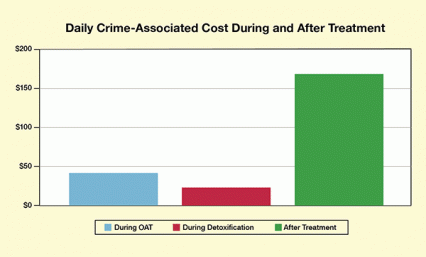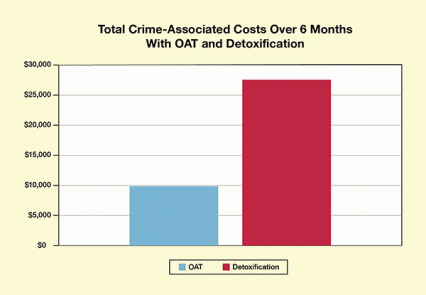Researchers found that:
- Patients with opioid use disorder generated crime-related costs to society at a lower rate while they were in treatment compared with after they left treatment.
- Patients who initiate time-unlimited opioid-agonist therapy will generate lower average total crime-related costs over the next 6 months than patients who initiate a 21-day detoxification regimen.
- Savings in crime-related costs are substantial and warrant inclusion in cost-effectiveness analyses of treatment for opioid addiction.
Many addiction specialists regard opioid-agonist therapy (OAT) with methadone or buprenorphine as an effective tool for mitigating the opioid epidemic. To the list of proven benefits of OAT, recent NIDA-supported research now adds savings in costs related to crime.
As part of an ongoing economic analysis of California’s drug treatment programs, Mr. Emanuel Krebs and Dr. Bohdan Nosyk, of the British Columbia Centre for Excellence in HIV/AIDS, estimated the state’s expenditures related to crimes committed by 31,000 patients during a median 2.3-year follow-up period that began with their initial entry into treatment for opioid use disorder. All the patients were treated in state-funded programs between the first day of 2006 and the last day of 2010.
 Figure 1. Daily Crime-Associated Costs During and After Opioid Agonist Therapy (OAT) and Detoxification Researchers calculated the amount patients generated per day in crime-related costs, including outlays for policing, courts, corrections, and criminal victimization. Patients generated crime-related costs, on average, of $41 per day while in opioid agonist therapy, and $23 per day while in detoxification. The difference was not statistically significant. Patients in both groups generated crime-related costs of $167 per day after leaving treatment.
Figure 1. Daily Crime-Associated Costs During and After Opioid Agonist Therapy (OAT) and Detoxification Researchers calculated the amount patients generated per day in crime-related costs, including outlays for policing, courts, corrections, and criminal victimization. Patients generated crime-related costs, on average, of $41 per day while in opioid agonist therapy, and $23 per day while in detoxification. The difference was not statistically significant. Patients in both groups generated crime-related costs of $167 per day after leaving treatment.During the follow-up, most of the patients participated in only one type of intervention, either time-unlimited OAT (usually with methadone) or 21-day detoxification; the rest participated in both types. Altogether, 43 percent of the patients interacted with the criminal justice system. The researchers used published reports to assign costs to each crime, including outlays for police, courts, corrections personnel and facilities, and victims’ injuries and property, income, and other losses. Their analysis indicated that the patients generated fewer crime-related costs on days when they were in treatment than on days after they left treatment. Patients who received OAT generated $126 per day less, on average, and patients who received detoxification generated $141 per day less, in crime-related costs when they were in treatment compared to after they left (see Figure 1).
 Figure 2. Total Crime-Associated Costs Over a Hypothetical 6-Month Period Researchers estimated that patients who initiated opioid agonist therapy (OAT) would spend a median 161 days in treatment during the ensuing 6 months, and those who initiated detoxification would spend a median 19 days in treatment. Because patients in OAT would spend more time in treatment, when crime-related costs are reduced [see Figure 1], their total crime-related costs over the 6 months would be $17,550 lower.
Figure 2. Total Crime-Associated Costs Over a Hypothetical 6-Month Period Researchers estimated that patients who initiated opioid agonist therapy (OAT) would spend a median 161 days in treatment during the ensuing 6 months, and those who initiated detoxification would spend a median 19 days in treatment. Because patients in OAT would spend more time in treatment, when crime-related costs are reduced [see Figure 1], their total crime-related costs over the 6 months would be $17,550 lower.The researchers next estimated the total crime-related costs that patients in the California programs would be expected to generate, on average, during the 6 months after they initiate OAT and detoxification. Based on the medical histories of the patients in their sample, they estimated that patients who initiated OAT would spend a median of 161 days of the 6 months in treatment, and those who initiated 21-day detoxification would spend a median of 19 days in treatment. Because patients who initiated OAT would spend a larger portion of the 6 months in treatment, when crime-related costs were reduced, they would generate significantly lower total crime-related costs: $9,774 versus $27,324, or a savings of $17,550 (see Figure 2).
Dr. Nosyk says, “We chose the 6-month period because that was the median length of an OAT episode in California during the study period. Extrapolating beyond that, we have seen that subsequent opioid-agonist–therapy episodes tend to last longer, and cost savings would likely increase over time rather than decrease."
Dr. Nosyk adds, “The costs of OAT are more than offset by the reduction in crime alone. In addition, OAT produces savings by reducing healthcare costs and improving worker productivity, among other means. There are also substantial health benefits to take into account, as individuals with opioid use disorder are 2.4 times more likely to die while out of treatment. We need to capture all of these savings and benefits over an extended time to evaluate publicly funded OAT accurately.”
Dr. Nosyk suggests that his team’s findings likely underrepresent the actual societal costs of crime and, consequently, the savings OAT can yield. In the analysis, he notes, “Total costs were driven by the number of individual interactions with the criminal justice system, for which we had comprehensive state-level data. However, many crimes do not result in arrest, and these costs were not captured.”
The researchers believe that their findings provide support for publicly funded OAT to improve public health and to reduce the economic impact of opioid dependence on society. “The clinical case for immediate access to OAT with no time restrictions for people presenting with opioid use disorders has been made. We hope that our research will reinforce the economic case to remove all barriers to accessing this evidence-based treatment for opioid dependence,” Dr. Nosyk says.
This study was supported by NIH grants DA031727, DA032551, and DA016383.
Source:
Krebs, E., Urada, D., Evans, E., et al. The costs of crime during and after publicly funded treatment for opioid use disorders: A population-level study for the state of California. Addiction 112(4):838–851, doi: 10.1111/add.13729, 2017. PMID 27981691 Abstract